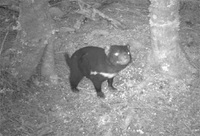Walkers in Tarkine rainforest enlisted in bid to save Tasmanian devil

Guests on guided, multi-day walks in Tasmania's remote Tarkine rainforest wilderness in 2012 are among the first people to monitor and view groundbreaking new research designed to save Tasmania's most iconic creature - the Tasmanian devil - with encouraging results so far.
Tarkine Trails is Australia's only rainforest walk, and the pristine wilderness in the North West corner of Tasmania is one of the last strongholds of devils unaffected by the mysterious and fatal Devil Facial Tumour Disease (DFTD) that has been decimating the population of the world's largest surviving carnivorous marsupial. Tarkine Trails has been running the walks in the little-visited corner of Australia's only island state for ten years and last year opened the Tiger Ridge standing camp that accommodates up to 12 guests.
In a unique tourism experiment, called The Tarkine Devil Project, Tarkine Trails and Bonorong Wildlife Sanctuary near Hobart - two tourism businesses with a shared passion for the Tasmanian devil, which is found nowhere else on earth, have joined together to place 40 motion-sensing cameras along Tarkine Trails' walking tracks. The cameras are being used to track populations of devils in a region described by University of Tasmania devil expert and project supervisor Dr Menna Jones as "a blank spot in our understanding of devil and other carnivore conservation." It is also one of the few areas of Tasmania into which the cancer has not yet spread.
"In 15 years we have lost 80% of our Tasmanian devils to the Devil Facial Tumour Disease," says Mark Davis, owner of Tarkine Trails, a Tasmanian guided-walks company. "This is crunch time and, along with our friends at Bonorong, we are going to do something about it."
Tarkine Trails guides, on top of their usual duties, are carrying with them batteries and memory cards that will keep the cameras running all year round. They collect the data as they go.
The tourism pioneers at Tarkine Trails have already retrieved two months worth of images from the 14 motion sensor cameras placed along their six day rainforest walk in the Tarkine's heart, the Savage River Rainforest. Davis says. "Contrary to common assumption, we've known for years that there are devils living in rainforest and now we've got the proof. We're really happy with the results so far, our guides are loving the research and so are the participants on our walks. Every single camera we placed caught images of devils. Better still, from the photos we've captured, not one devil has displayed signs of the facial tumour disease, which is a huge relief."
The really clever thing about this project is the way that it uses the resources we have available," said Davis. "Our guides regularly walk through these remote areas. Along with our walkers, they will act as field researchers where it has previously been too expensive to conduct research."
"The Tarkine is really such an unknown area for devils," said Bonorong director Greg Irons, who has funded the set up and management of the project as well as setting up Tasmania's only 24-hour wildlife rescue service. "While we are breeding devils in captivity at Bonorong and elsewhere, the best chance the devil has is to survive in the wild. But we need to know much more about them if we are going to ensure they do not go the way of the Tassie Tiger, now presumed extinct."
At the end of each day, guests view the images collected by the cameras, giving them a unique insight into the research that they are helping to make possible. Echidnas, pademelons and quolls have also been caught on camera.
"This project is about enfranchising people," says Davis. "It's about letting people know that even while they are on a holiday and having an amazing experience, they can be part of something special and worthwhile."
Dr Chris Boland, Science Manager of the Tasmanian Government's Save the Tasmanian Devil Program said: "I really like the way the project enables the community to engage in valuable scientific research. In fact, I think it is a really unique and valuable approach. The project not only collects scientific data from a remote part of the state, it also serves to educate the community about devils, and gives the community a sense of ownership over the plight of these amazing Tasmanian creatures."
The project is designed to run for at least ten years with initial funding coming from a grant from the Tasmanian government's Save the Tasmanian Devil Project Appeal.
The cameras have been operating for two months now and results are uplifting. "There's devils everywhere," says Davis. "We're finding them in places we didn't expect them. It's so exciting for the guests to sit down at the end of the day, grab a glass of wine and discover what is really wandering around out there."
For more information and short videos on the Tarkine Devil Project, and on the available walks, visit tarkinetrails.com.au/tarkine-devil-project/
For further information on visiting Tasmania, visit discovertasmania.co.uk.

